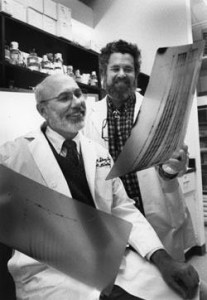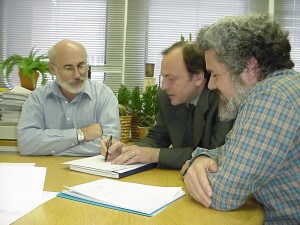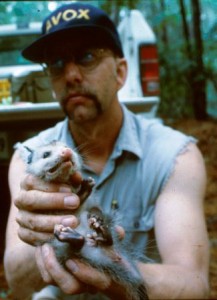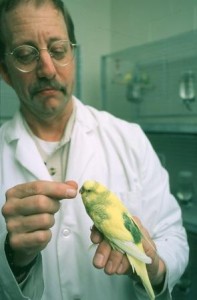Natural Causes: Untangling the Mysteries of Aging
By Hudson Lockett
The story of aging is a tale billions of years in the telling. Every one of your ancestors did it, in an unbroken lineage running from the very first single-celled organisms on through the titans of the Jurassic period right down to your mom and dad. And like dear old ma and pa every one of your cells is prey to seemingly inscrutable molecular catastrophes that bring you step by achingly tiny step toward inexorable expiration.
Or maybe not.
In the first decade of the new millennium a series of scientific discoveries have fundamentally changed the way many scientists look at aging. Research on the protective caps found at the ends of our coiled-up DNA, which put the brakes on cell division as they wear out, got the Nobel Prize in 2009. Academic journals regularly publish new findings on the genes that might control aging processes, and the proteins those genes create are being microscopically poked and prodded for their secrets. Even the structures that power the cell play an unexpected role in cell suicide, lending credence to theories that all of the above may be intimately interconnected in a process we can actually do something about—something, but probably not everything and certainly not yet. Along with progress have come profit-seekers hoping to capitalize on hype-laden headlines, much to the chagrin of cell biologist and geneticist Jerry Shay at the University of Texas Southwestern Medical Center in Dallas. Some Web sites are already offering life extension therapy supposedly based on discoveries in Shay’s field of research.
“None of these are going to make you live forever,” Shay said in a voice equally emphatic and exasperated. “If they were, I’d be taking them.”
Shay and his research partner Woodring Wright have been researching the role of telomeres — the protective caps at the ends of our chromosomes, or coiled-up DNA, that limit cell division — for more than 20 years. In that time, the capacity for moneymaking schemes based tenuously on their work has only increased.
“There’s a lot of Bernie Madoffs running around out there in the aging snake oil business,” Shay said. Companies are free to bypass the FDA and promise aging panaceas by the boatload by marketing their products as “nutraceuticals.” But the truth behind and surrounding the scientific research on why we grow old is much more complex, and perhaps more promising, than the latest generation of anti-aging hucksters would have us believe.
Telomeres and Telomerase
Shay suspects telomeres may account for no more than 10 to 20 percent of the aging process, and Wright says it might be as little as 5 percent. “Basically there’s been a lot of media hype about telomeres being the counting mechanism that controls aging,” Wright said. Last year’s Nobel Prize for medicine went to three American scientists for their research into telomeres, generating headlines such as “Nobel Winners Isolate Protein Behind Immortality, Cancer” in Wired magazine.
Telomeres are the repeating lengths of genetic code at the ends of our chromosomes that get worn down each time a cell divides. Eventually telomeres are worn away completely, leaving the chromosome proper– and the DNA therein– vulnerable to wear and tear. When the exposed chromosome ends begin to fray the cell loses the genetic instructions that tell it how to function and replicate. The enzyme telomerase adds length to telomeres, pushing the end of the line (known as the Hayflick limit) back to a later date.
But telomerase is also present in almost all cancers, Shay says, and it’s no coincidence. When a line of cells become immortal — able to divide an unlimited number of times — the cells can keep racking up chance genetic mutations in their DNA well past what a normal cell sees in its limited lifetime. It’s these mutations that can trigger a cascade into malignancy, resulting in out-of-control cancer cells. Wright and Shay say the Hayflick Limit could have evolved as an anti-cancer mechanism. But introducing telomerase to healthy cells doesn’t cause cancer; it simply lets them live longer thanks to lengthened telomeres. Therein lies the enzyme’s allure: the potential for longer-lived healthy cells in longer-lived healthy humans.
Although both Shay and Wright think the shortening is relative to aging, Wright says the image presented in the popular media is a “vast overstatement.”
Telomeres first rose to prominence in 1985 when Elizabeth Blackburn and Carol Greider, then at the University of California Berkeley, discovered the repeating elements at the ends of chromosomes of a species of freshwater protozoa (Tetrahymena thermophila). In 1989, the duo co-authored a paper showing an enzyme, telomerase, is required to create new telomeres. (The two, along with Harvard genetics professor Jack Szostack, were honored with the 2009 Nobel Prize in Physiology or Medicine.)
Shay said Blackburn’s findings “transformed the field from pond scum into pathology,” piquing his and Wright’s interest. A few years later they proposed the model of telomere shortening through cell division and lengthening by telomerase.
Their lab soon adopted Michael West, a graduate student skeptical of their model in the absence of conclusive evidence. When a 1990 paper proved the Shay-Wright model correct, West became, in Shay’s words, “a born-again telomere biologist.” That year West started a small company named Geron that has since become one of the biggest corporate names in gerontology. Shay and Wright are each on the company’s advisory board.
Geron is about to enter the home stretch for FDA approval of one of its telomerase-inhibiting anti-cancer drugs, Imetelstat. The drug blocks the production of telomerase in cancer cells. This lets telomere ends wear down until the cells become senescent — unable to divide and mortal once more.
Shay says the applications of their research go beyond aging, including the possibility of growing new skin for burn victims; with the limit snapped on how many times a cell can divide, people could become their own perfect donors. Skin grafts with the recipient’s DNA could be grown in the lab and grafted on without risk of rejection.
Yeast Genes, Our Genes
Perhaps the only areas of the cell getting more attention than telomeres are the genes thought to be the root of many aging processes. Not coincidentally, they are also related to another popular haunt in the cottage industry of immortality: crash dieting. Scientists have known for more than 70 years that calorie restriction extends life span in a variety of organisms. Since that discovery plenty of low-intake diets have claimed to produce those results in humans. MIT professor Leonard Guarente says that when he told his bosses in 1991 that he wanted to research the roots of aging in baker’s yeast, many thought he was devoting his career to a lost cause.
“I think the root of it was that the history of aging as an experimental subject was kind of checkered,” Guarente said. With little work to build on, he and a few graduate students began the years-long slog of cultivating generations of yeast and nearly starving them to single out the longest-lived lines. Not only did they find a gene responsible for some aging processes in yeast, they laid the groundwork for the discovery of its human counterpart. Guarente says the leap from simple single-celled fungal experiments to the idea of keeping age-related disease at bay in humans is one of the biggest developments of the past decade. “And the fact that you have the potential of manipulating a small number of genes and affecting a broad class of diseases, that’s a pretty spectacular possibility,” he said.
The type of gene that may be affecting aging is one that responds to calorie restriction. These genes produce a protein that kicks cellular survival mechanisms into high gear when food is scarce. Organisms that can survive the longest without sustenance, be they baker’s yeast or bakers, are more likely to pass on the genes responsible for the ability when food becomes plentiful again.
Guarente says scientists are publishing so many papers on these genes and the proteins they produce, called sirtuins, that it’s hard to keep up. In experiments on fruit flies, a sirtuin-activating compound named Resveratrol extended lifespan without any of the nasty side-effects of low calorie diets (such as sterility). How this plays out on the molecular level isn’t entirely clear yet, which is cause for consternation among some scientists who question whether Resveratrol is really working on the gene in question.
Even so, “few are willing to dismiss sirtuin activators until they see the outcomes of [biotech company] Sirtris’s clinical trials,” Heidi Ledford wrote in the March 2010 Nature.
Guarente is used to the hubbub and says such scrutiny has benefited aging research in the long run by making its proponents show their work. “There’s a lot of debate, as there is whenever something important is not solved yet,” he said.
Of Mice and Proteins
Another media darling is the experimental drug rapamycin. In three experiments the drug prolonged the life of aged lab mice by 30 percent, finally convincing one of its biggest skeptics, professor Steven Austad of the University of Texas Health Science Center at San Antonio. In a Wired.com article, Austad called the results “particularly significant.”
Given his background, those were two hard-won words. While Shay and Wright were flirting with telomeres in the ’80s,
Austad was embarking on what was supposed to be a long and rewarding career in field biology. Trained for observation and analysis in the out-of-doors, Austad began studying the habits of opossums in the tropics of South America. He soon noticed “quite by accident” that they aged much faster than similarly sized mammals. Cats can live a dozen years or more. Opossums only get 18 months. Intrigued, Austad traded in his muddy boots for a lab coat. He’s still trying to find out why certain animals are exceptionally long- or short-lived: Marmosets, rat-sized primates, live only 12 years. Bivalve mollusks, meanwhile, can top out at more than four centuries. “What I really brought to the field was a zoologist’s perspective,” Austad said. He remained skeptical of rapamycin until it had been shown to work not just in lab mice — bred for genetic stability and similarity as a sort of experimental yardstick — but in genetically dissimilar rats from three separate labs.
Although the exact mechanisms behind animal aging differences remain a mystery, Austad’s latest experiments are yielding promising results. “One of the things we think is critical is their ability to maintain their proteins,” he said. The proteins that keep cells running are bombarded by molecular potshots as soon as they’re made. But when Austad’s lab tries to damage proteins in the cells of long-lived animals they prove unusually resilient. To figure out what was responsible, researchers placed the same protein in two soups made up of cellular stuff from different species. Austad says early results indicate the proteins themselves are nothing special; something else in the cells is responsible. “We take a protein and put it in the soup from a mouse, it behaves like a mouse protein. Put the same one in a bat, it thinks it’s a bat protein.” In short, the proteins are getting outside help from inside the cell. The next step is finding out from where.
Ballpark Numbers
Asked for a rough estimate, Austad pegged the genetic component of aging at around 25 percent, with lifestyle accounting for 50 to 60 percent. “The rest is probably made up of things that we have no idea about,” he said. He’s not suggesting we can perfect anything about the aging process: “We’ll probably still die from the same things, only hopefully they’ll be more abrupt.”
Austad cites a recent study of centenarians, many of whom had never been to a doctor. When they do get sick, though, “They’re gone in a hurry.” This concept, known as compressed morbidity, doesn’t envision a scientific fountain of youth but rather a slowed accumulation of damage. “Ultimately what we’d like is for people to stay very, very healthy and one day fall over dead,” Austad said. “And of course we’d like that date to be as old as possible.”
Most gerontologists, after making clear they’re not promising you immortality, are quick to point out there is a difference between the fundamental aging process and aging-related diseases. Aging entails increased frailty as cells gradually accumulate damage. Aging-related diseases simply become much more likely as we get older. According to a paper in Nature in 2000, a rapid increase in cancer risk between ages 40 and 80 produces a lifetime cancer risk of nearly 1 in 2 in industrialized countries.
And thanks to protective measures such as vaccines and societal changes such as agriculture that make humans less likely to die from starvation, the number of people worldwide facing the likes of Alzheimer’s, Parkinson’s, type 2 diabetes and cardiovascular disease is set to skyrocket.
Mitochondria Shuffle
Whitney Yin, an assistant professor in chemistry and biochemistry at UT Austin, studies mutations in mitochondrial DNA related to human disease. Mitochondria are best known as the power plant of the cell for their role in producing ATP, a high-energy compound that fuels functions vital to cell life. Malfunctioning mitochondria are present in every one of the diseases mentioned above. Yin says she doesn’t consider herself a gerontologist, but her organelle (cell component) of choice may play an important role in the aging process. Yin suspects that while aging likely has many causes, “it’s clearly related to the dysfunction of mitochondria.”
The original mitochondrion is thought to have hitched a ride inside one of our single-celled ancestors millions of years ago, starting a relationship that continues today. The mitochondria in human cells often number in the thousands.
While our ancestral cells gained a potent energy source, mitochondria found themselves shielded from predation inside their host cell. This symbiotic relationship means mitochondria retain their own DNA, well outside the nucleus’ protective walls. The process they use to power cells produces free radicals, oxidating molecules that can damage DNA. Although a defense system of antioxidants is in place, the proximity of mitochondrial DNA to those free radical factories can muck up their 37 genes — tipping the balance to favor a vicious cycle of DNA damage. As noted in Nature in 2006, researchers have observed that increased antioxidant defenses against free radicals in mitochondria can increase longevity, and a 2004 study in the journal suggested that oxidative damage has a major role in the cognitive decline that comes with aging.
Yin, more concerned with age-related diseases than aging, is skeptical of living forever. But she does think that quality and length of life can be increased. “I think the aging process can be slowed down,” she said. Just not stopped.
Less bombastic mutations in mitochondrial DNA simply accumulate with age and correlate with a decline in energy production. As chronicled by a 2006 study in the Italian journal Biochimica et Biophysica Acta, mitochondrial DNA mutations quickly built up among lab mice whose DNA-proofreading proteins were disabled. The mice appeared normal at first but soon showed signs of aging typical of humans, including weight loss and osteoporosis. Energy production by their mitochondria decreased, and their median lifespan was less than half the typical two years. It’s no coincidence, Yin said, that we feel low on energy as we get older.
Apoptosis, or programmed cell death, is one method thought to mitigate these mutations, and Yin says the discovery of mitochondria’s role in cell suicide is one of the biggest of the past decade. If a cell’s DNA gets damaged enough, mitochondria will swell to bursting, releasing proteins that cause the cell to self-destruct. But in tumor cells this chain reaction is usually shut off, making it a hallmark of cancer-like telomerase, although Yin said the phenomena don’t always go hand in hand. It all depends on the cells in question. Liver cancer is different from lung cancer, and there are more than 100 diseases related to mitochondrial dysfunction. Yin says that mitochondria dysfunction and telomerase presence could have common genetic roots, that they “may be connected through common gene signaling pathways, but we don’t know yet.”
Two Steps Forward …
A new theory suggesting exactly that made its debut in the March 2010 edition of Nature. Where once many theories competed to be the sole explanation for the aging phenomenon, multicausal views now dominate the field. The Nature study suggests that the interplay among regulating proteins, mitochondria, and telomere damage form an “axis of aging.”
Age-associated telomere damage is linked to the activation of a protein, named P53, that prevents cancer and regulates the cell cycle in humans. When activated, P53 may both limit the ability of stem cells to replace aged ones and cause mitochondria to malfunction. Mutated mitochondria produce more damaging free radicals, which increases activation of P53. This in turn affects the tissues made of those cells and the organs made of those tissues — and ultimately the humans made of those organs. While this process does have a clear benefit (preventing cancer), it also contributes to aging from the cellular level on up.
Guarente at MIT notes that even stem cells, hailed for their adaptive and regenerative potential, can accumulate damage thanks to oxidization as well, eventually succumbing to apoptosis. Muscle cells are one example. “They may be stem cells, but they get old too,” he said.
Guarente says some seemingly disparate areas of research are crossing paths, especially in the case of sirtuins and mitochondria. There are six other sirtuin proteins aside from the one his lab identified, and three of them are found in mitochondria. “I think you can link together a lot of these ideas at this point into a coherent picture,” he said. An increasingly holistic picture of aging may yet emerge within the cramped confines of the cell.
Whatever progress is made, most gerontologists remain wary of possible associations with the roundly despised snake-oil salesmen. Jerry Shay at UT Southwestern is outspoken in his criticism of cure-alls that flout FDA regulation, which often make claims to ancient Far Eastern wisdom that scientists have supposedly confirmed. Since Congress passed the Dietary Supplement Health and Education Act in 1994, the FDA has been limited in its ability to police the industry.
That may soon change. A recent editorial in Nature applauded the introduction of the Dietary Supplement Safety Act of 2010, which if it passes would require manufacturers to register with the Health and Human Services secretary and give the FDA the authority to immediately recall any supplements that are misbranded or pose a health threat. The weight loss supplement ephedra was banned in 2004, but only after the FDA conducted its own study. That ban targeted use of ephedra supplements for weight loss, muscle building and better athletic performance. According to a 2004 New York Times article on the ban, the supplements had been linked to heart attack, stroke and sudden death “because of their ability to raise blood pressure, increase heart rate and speed up brain activity.” The article focused on the exception made by the FDA for the use of the herbal stimulant in Chinese medicine, which uses smaller doses of ephedra with other traditional curatives as a treatment for colds, asthma and other short-term ills.
Snake oil, which also has roots in Chinese medicine, may be unduly maligned today by its status in scientific slang. A 1989 letter by Richard Kunin printed in the Western Journal of Medicine pointed out that Chinese snake oil purchased over the counter contained substantial omega-3 fatty acids that might act like cod liver oil. Chinese snake oil, Kunin wrote, could be “a credible anti-inflammatory agent and might indeed confer therapeutic benefits” for arthritis and joint pain. “I find it humbling,” he wrote, “that the science of today invests the quackery of yesterday with new credibility.”
However, Shay says, the supplements marketed today as aging panaceas are at best a waste of money. This makes him doubly aware of the danger of promising any sort of aging reversal through telomerase therapy before there’s substantial evidence it can deliver. The Nature editorial warning against dubious life-enhancing elixirs took pains to caution scientists on how their discoveries can be misinterpreted: “Anything researchers say in the media must strike a careful balance between science, hope and hype.”
Zeitgeist of Aging
Still, sentiments like these suggest a shift in the scientific zeitgeist away from a fatalistic view of aging as an incomprehensibly random build up of molecular damage. Even those who don’t consider themselves gerontologists, such as UT’s Yin, think that at least some progress can be made. Among gerontologists, however, there are some holdouts. Perhaps the most prominent is Leonard Hayflick, discoverer of the upper limit to cell division, now at the University of California at San Francisco. In 2004, he wrote bluntly in the Journal of Gerontology: “No intervention will slow, stop, or reverse the aging process in humans.”
At the other end of the spectrum is Aubrey de Grey, who in appearances on national media and in his 2001 book Ending Aging says he intends to live for 1,000 years. In his book, De Grey details a strategy called “strategies for engineered negligible senescence” that can be likened to car maintenance done regularly to decrease the chances of breaking down. SENS relies on escalating advances in seven areas of aging research to extend the human lifespan long enough to reach the next big breakthrough.
Even the cautious Jerry Shay sits on the research advisory board of the nonprofit SENS Foundation. De Grey also helped found the Methuselah Foundation, which offers a cash prize to encourage researchers to find a way to significantly extend the lifespan of aged mice. Austad is a resource advisor for the foundation, and Leonard Guarente is listed as a competitor. Most scientists interviewed for this article were less grandiose in their claims than de Grey but no less bold in embracing the potential for a longer, healthier-lived humanity — an idea Austad thinks hasn’t filtered out to the general public. This may be in part due to the universality of aging. Everyone does it, so the process is perceived as normal.
But those that don’t age in line with our expectations can provide insight into how normative aging works. Children with Werner syndrome begin to show signs of premature aging at puberty: accelerated telomere shortening, graying hair, osteoporosis and cataracts. At the opposite end of the spectrum is Brooke Greenberg. Born in Maryland in 1993, she remains outwardly a toddler because of a condition called developmental disorganization: Her body isn’t developing as a coordinated unit, according to a 2009 case study. Her mental capacity is estimated at somewhere between 1 and 8 months old. The study estimated her dental age at 8 years and her bone age at 10. When, chronologically speaking, she was 13 years old, researchers found that her telomeres were much shorter than others’ of the same age.
While scientists who daily deal with the nuts and bolts of aging may be convinced of the potential for progress, “Most people’s perspective still is that aging is something that nothing can be done about,” Austad said. But that, too, could soon change: “Twenty years ago, who would have thought that giving a 60-year-old person [a pill] would make them live 30 years longer? But now we can do that in a mouse.”
Those humble roots belie big strides. After decades of being dogged by a checkered past and con-artist hangers-on, the field of aging has finally grown up.



